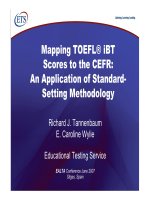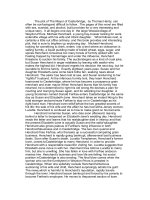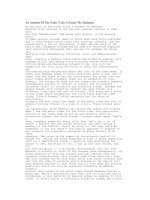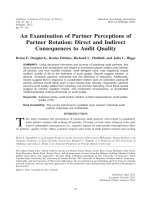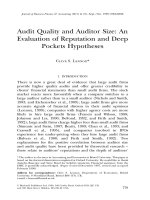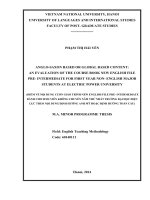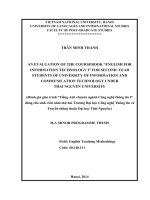AN EVALUATION OF TRANSLATION QUALITY OF LITERARY WORKS
Bạn đang xem bản rút gọn của tài liệu. Xem và tải ngay bản đầy đủ của tài liệu tại đây (9.54 MB, 412 trang )
VIETNAM NATIONAL UNIVERSITY
UNIVERSITY OF LANGUAGES AND INTERNATIONAL STUDIES
PHẠM THỊ THỦY
AN EVALUATION OF TRANSLATION QUALITY OF
LITERARY WORKS (PROSE)
Major: English Linguistics
Code: 62.22.15.01
A Thesis Submitted in Total Fulfillment of the Requirements for the
Degree of Doctor of Philosophy
Supervisor: Associate Prof. Lê Hùng Tiến (Ph.D)
HANOI – 2015
ii
STATEMENT OF AUTHORSHIP
Except where reference is made in the text of the dissertation, no other person‟s work has
been used without due acknowledgement in the main text of the dissertation.
The dissertation has not been submitted for the award of any degree of diploma in any other
tertiary institutions.
PHẠM THỊ THỦY
Date:
iii
TABLE OF CONTENTS
PART I: INTRODUCTION 1
1. Rationale of the study 1
2. Aims of the study 3
3. Research questions 4
4. Scope of the study 4
5. Methodology 5
6. Contribution of the study 5
7. Organization of the study 6
PART II: DEVELOPMENT 8
CHAPTER 1: REVIEW OF THE LITERATURE ON TRANSLATION QUALITY
ASSESSMENT 8
1.1. Concept of translation in three different approaches 8
1.1.1. Literature-oriented approaches 8
1.1.2. Skopos-related approaches 9
1.1.3. Linguistics-based approaches 9
1.1.4. Summary 12
1.2. Concept of translation quality assessment in three different approaches 12
1.2.1. Definition of translation quality assessment 13
1.2.2. Literature-oriented approaches 13
1.2.3. Skopos-related approaches 13
1.2.4. Linguistics-based approaches 14
iv
1.2.4.1. Early linguistics-based approaches 14
1.2.4.2. Later linguistics-based approaches 16
1.2.5. Summary 16
1.3. Translation quality assessment (TQA) models 16
1.3.1. Non-comparative model: Toury
‟
s model 17
1.3.2. Comparative models 18
1.3.2.1.
Nord‟s
TQA model 18
1.3.2.2. Newmark
‟
s TQA model 19
1.3.2.3. House
‟
s TQA model 20
1.3.2.4. Discussion on
Nord‟s
model, Newmark
‟
s model and House
‟
s model 22
1.3.3. Summary 23
1.4. A detailed description of House
‟
s TQA model 24
1.4.1.
House‟s
(1977) original TQA model 24
1.4.1.1. Theoretical bases of House
‟
s original model 24
1.4.1.1.1. Three aspects of meaning and concept of equivalence 24
1.4.1.1.2. Functions of language vs. functions of texts 25
1.4.1.1.3. A model for establishing functional equivalence 27
1.4.1.2. Operation of House
‟
s original model 31
1.4.1.2.1. Method of analyses and comparison of texts 31
1.4.1.2.2. Evaluation scheme 32
1.4.2.
House‟s
revised (1997) TQA model 33
1.4.2.1. Modifications to House
‟
s original model 33
1.4.2.1.1. Register analysis of field, tenor, and mode 35
1.4.2.1.2. Genre 36
1.4.2.1.3. A functional-pragmatic TQA model 39
1.4.2.2. Operation of House
‟
s revised model 40
1.4.2.3. Overt and covert translations 41
v
1.4.2.4. Cultural filter 42
1.4.3. Summary 44
1.5. Concluding remarks 45
CHAPTER 2: RESEARCH METHODOLOGY 48
2.1. Research methodology 48
2.1.1. Mixed approaches and specific methods 48
2.1.1.1. Mixed approaches: qualitative and quantitative 48
2.1.1.1.1. Qualitative approach 48
2.1.1.1.2. Quantitative approach 49
2.1.1.2. Specific methods 51
2.1.2. Analytical framework 51
2.1.2.1. Qualitative analytical procedure 51
2.1.2.2. Quantitative analytical procedure 55
2.1.2.3. Multiple-choice Discourse Completion Task 55
2.1.2.4. Focus group interview 60
2.1.3. Summary 61
2.2. Data collection 62
2.2.1. Data for qualitative analyses 62
2.2.2. Data for quantitative analyses 64
2.2.3. Data for analyses of translation naturalness 64
2.2.3.1. Data from MDCT 64
2.2.3.2. Data from focus group interview 65
2.2.4. Summary 66
2.3. Concluding remarks 66
CHAPTER 3: FINDINGS FROM QUALITATIVE ANALYSES AND DISCUSSIONS 68
vi
3.1.
„
Southern
Skies‟
(ST No.1) –
„
Trời Nam lồng
lộng‟
(TT No.1) 68
3.1.1. Analysis of ST No.1
„
Southern Skies
‟
68
3.1.2. Comparison of ST No.1
„
Southern Skies
‟
and TT No.1
„
Trời Nam lồng lộng
‟
75
3.1.3. Categorization of TT No.1
„
Trời Nam lồng lộng
‟
83
3.2.
„
Abbreviati
on‟
(ST No.2) –
„
Tên viết tắt
‟
(TT No.2) 83
3.2.1. Analysis of ST No.2
„
Abbreviati
on‟
83
3.2.2. Comparison of ST No.2
„
Abbreviation
‟
and TT No.2
„
Tên viết tắ
t‟
84
3.2.3. Categorization of TT No.2
„
Tên viết
tắt‟
92
3.3.
„
Jo
e‟
(ST No.3) –
„
Thằng Joe
‟
(TT No.3) 92
3.3.1. Analysis of ST No.3
„Joe‟
92
3.3.2. Comparison of ST No.3
„Joe‟
and TT No.3
„
Th
ằ
ng
Jo
e
‟
92
3.3.3. Categorization of TT No.3
„
Thằng
Joe‟
100
3.4.
„
The Hottest Night of the
Century‟
(ST No.4) –
„
Đêm nóng nhất thế kỷ
‟
(TT No.4) 100
3.4.1. Analysis of ST No.4
„
The Hottest Night of the Century
‟
100
3.4.2. Comparison of ST No.4
„
The Hottest Night of the Century
‟
and TT No.4
„
Đêm nóng nhất
thế kỷ
‟
100
3.4.3. Categorization of TT No.4
„
Đêm nóng nhất thế kỷ
‟
106
3.5.
„
Hostage
s‟
(ST No.5) –
„
Con
tin‟
(TT No.5) 107
3.5.1. Analysis of ST No.5
„
Hostages
‟
107
3.5.2. Comparison of ST No.5
„
Hostages
‟
and TT No.5
„
Con tin
‟
107
3.5.3. Categorization of TT No.5
„
Con tin
‟
112
vii
3.6. Concluding remarks 113
CHAPTER 4: FINDINGS FROM QUANTITATIVE ANALYSES & ANALYSES OF
TRANSLATION NATURALNESS AND DISCUSSIONS 115
4.1. Quantitative analyses of personal pronouns, and of passive vs. active sentences 115
4.1.1. Personal pronouns 115
4.1.2. Active vs. passive sentences 120
4.1.3. Summary 124
4.2. Analyses of translation naturalness 125
4.2.1. Analyses of translation naturalness based on data from MDCT 125
4.2.2. Analyses of translation naturalness based on data from focus group interview 129
4.2.3. Summary 132
4.3. Concluding remarks 133
PART III: CONCLUSION AND IMPLICATIONS 136
1. Major findings 136
2. Contributions of the study 142
3. Pedagogical implications 143
4. Criticism of House
‟
s Model 143
5. Limitations of the study 144
6. Suggestions for further research 144
ARTICLES AND PROJECTS RELATED TO THE DISSERTATION 145
REFERENCES 146
APPENDICES 155
viii
Appendix A: STs 155
Appendix A.1: ST No. 1 “Southern Skies” 155
Appendix A.2: ST No. 2 “Abbreviation” 173
Appendix A.3: ST No. 3: “Joe” 189
Appendix A.4: ST No. 4: “The Hottest Night of the Century” 195
Appendix A.5: ST No. 5: “Hostages” 205
Appendix B: TTs 211
Appendix B.1: ST No. 1 “Trời Nam lồng lộng” 211
Appendix B.2: TT No.2 “Tên viết tắt” 229
Appendix B.3: TT No. 3 “Thằng Joe” 246
Appendix B.4: TT No. 4: “Đêm nóng nhất thế kỷ” 252
Appendix B.5: TT No. 5: “Con tin” 269
Appendix C: Linguistic background for analyzing and comparing Vietnamese communicative
preferences and norms 275
Appendix D: Analysis of ST No. 2, No.3, No.4, and No.5 287
Appendix D.1: Analysis of ST No.2
„
Abbreviation
‟
287
Appendix D.2: Analysis of ST No.3
„
Jo
e‟
293
Appendix D.3: Analysis of ST No.4
„
The Hottest Night of the Century
‟
299
Appendix D.4: Analysis of ST No.5
„
Hostages
‟
305
Appendix E: List of addressee – directing utterances in the STs and TTs 311
Appendix F: Translations of English personal pronouns in the TTs 314
ix
Appendix G: Translation of English passive sentences in the TTs 283
Appendix H: Replacement of nouns in the STs by verbs in the TTs 295
Appendix I: MDCT 300
Appendix I.1: MDCT 300
Appendix I.1.1: MDCT – version 1 300
Appendix I.1.1.1: MDCT – Lecturers of English 301
Appendix I.1.1.2: MDCT – Postgraduate students of English 305
Appendix I.1.1.3: MDCT – English-major senior undergraduate students 309
Appendix I.1.1.4: MDCT – Senior undergraduate students of Literature and Linguistics 313
Appendix I.1.2: MDCT – version 2 317
Appendix I.2: Samples of MDCT 320
Appendix I.2.1: Samples of MDCT – version 1 320
Appendix I.2.1.1: Sample No.1 – Lecturers of English 320
Appendix I.2.1.2: Sample No.2 –Postgraduate students of English 324
Appendix I.2.1.3: Sample No.3 – English major senior undergraduate students 328
Appendix I.2.1.4: Sample No.4 – Senior undergraduate students of Literature and
Linguistics 332
Appendix I.2.2: Sample No.5 – MDCT - version 2 340
Appendix I.3: MDCT Data 343
Appendix I.4: Information about MDCT respondents 346
Appendix J: Focus Group Interview 348
Appendix J.1: Data for focus group interview 348
Appendix J.2: Transcript of focus group interview 349
Appendix J.3: Summary of focus group interview and choices of translation naturalness 360
Appendix J.4: Summary of results of focus group interview 365
x
LIST OF FIGURES
Figure 1.1: A Scheme for Analyzing and Comparing Original and Translation Texts 34
Figure 2.1 Components of language competence 56
Figure 4.1 Frequency of occurrence of Vietnamese personal pronouns and kinship nouns as
translations of the pair
„
I-Y
ou‟
118
Figure 4. 2 Three types of passive sentences in the STs and their translations in the TTs 123
Figure 4. 3 Translation of passive sentences in the STs into Vietnamese in the TTs 124
xi
LIST OF TABLES
Table 4. 1: Frequency of occurrence of Vietnamese personal pronouns and kinship nouns as
translations of the pair
„
I-Y
ou‟
116
Table 4. 2: Number of passive sentences in the STs and their translations in the TTs 121
Table 4. 3: Passive types in the STs and their translations in the TTs 122
Table 4. 4: Verb and noun choice by respondents (five groups of respondents) 126
Table 4. 5: Verb and noun choice of seven sentences among individual groups of respondents 128
xii
ABBREVIATIONS
DCT Discourse Completion Task/ Test
EFL English as Foreign Language
ESL English as Second Language
L1 First language
L2 Second language
MDCT Multiple-choice Discourse Completion Task/ Test
N Noun
ST Source text
TQA Translation quality assessment
TT Target text, Translation text
V Verb
xiii
ACKNOWLEDGEMENTS
I would like to express my sincere thanks to many people who have assisted my research
work.
I am indebted to my supervisor, Associate Prof. Dr. Lê Hùng Tiến, for his
encouragement, insightful comments on the content and research methods, as well as interest
in my research. I would like to thank the staff of Post Graduate Department, University of
Languages and International Studies, VNU, for their assistance that has made the realization
of the dissertation possible.
My sincere thanks also go to Prof. Dr. Hoàng Văn Vân, Dean of the School of Graduate
Studies, VNU; Dr. Huỳnh Anh Tuấn, Dean of Post Graduate Department, ULIS–VNU;
Associate Prof. Dr. Lâm Quang Đông, Head of Office of Science and Technology, ULIS–
VNU; Associate Prof. Dr. Trần Xuân Điệp, Hanoi National University of Education; Prof.
Dr. Nguyễn Quang, ULIS–VNU; Associate Prof. Dr. Nguyễn Văn Độ, Thăng Long
University; and Dr. Nguyễn Đức Hoạt, Foreign Trade University for their invaluable
suggestions and comments on the methodology and other issues related to the dissertation.
Their willingness to support me, to answer my questions, and to comment on the dissertation
content and organization, especially on the methodology has given me more confidence in
doing research in this challenging area.
I also owe two independent examiners my thanks for their detailed, critical, but positive
comments on the dissertation.
I take this opportunity to thank the Board of Rectors of International School - Vietnam
National University, Hanoi, and my colleagues of the Foreign Languages Department at IS –
VNU, for their assistance during the time I did my research.
I would also like to thank the survey respondents and focus group interviewees inside and
outside VNU, who contributed to the data of this study. My thanks also extend to Mr. Trịnh
Lữ, the translator of the Australian Short Stories Collection, for allowing me to use his
translations in this study.
xiv
Finally, I would like to give my thanks to my husband, Đoàn Xuân Trường, and my two
sons, Đoàn Minh Thành and Đoàn Minh Trí, for their support and encouragement. Without
their support and encouragement it would be far more difficult for me to pursue my research.
xv
ABSTRACT
The present study focuses on the evaluation of translation quality of English-Vietnamese
fictional prose, more specifically, of English-Vietnamese short stories. To achieve this aim,
we have taken the data from Australian Short Stories collection (2005). The data comprise
five Australian short stories (with the total word count being 19,725) and their translations.
The data for the research also collected from a survey questionnaire conducted on 370
native Vietnamese speakers, and a focus group interview to validate the naturalness of a
number of sentences in the Vietnamese translations.
The research methods employed in this study are a combination of qualitative analyses
by means of House‟s (1997) functional-pragmatic model of translation quality assessment
(TQA), the main method, quantitative analyses by adapting House‟s (2006) method,
Multiple-choice Discourse Completion Task (MDCT), and focus group interview.
The review of literature on translation evaluation shows that House‟s functional-
pragmatic TQA model is highly appropriate for assessing fictional prose translations
because it, firmly based on contemporary research on literary criticism, takes into account
both the source text (ST) and the target text (TT). Applying this model, the assessor can
discover not only the merits and shortcomings of the translations, but also the cultural
aspects of the STs and TTs, which are linguistically manifest.
The findings reveal that all the five TTs are target text focused (covert translations), in
which the translator has adapted the ST‟s norms to those of the TT. The findings have
pointed out several mismatches between STs and TTs along the dimension of Tenor in
House‟s model, which include the use of different Vietnamese personal pronouns and
kinship nouns for the same English personal pronoun, the shifting of nouns in the STs into
verbs in the TTs, and the transformation of a variety of passive sentences in the STs into
active ones in the TTs.
In addition, this study suggests that the Australian original texts and the Vietnamese
translation texts are equivalent at the level of ideational functional component, and at genre
level in House‟s model. However, the researcher argues that the interpersonal functional
component in the TTs to some extent is more marked than in the STs.
1
PART I: INTRODUCTION
1. Rationale of the study
In the era of globalization, there is a great need to exchange culture and literature
among nations. As a result, over the last ten years, together with the development of the
Internet, a large number of literary works have been translated into Vietnamese, as Trần
Đăng Khoa ( in CPV, 11 August 2012) remarks: „the majority of books available in
Vietnamese market are translated ones, thus, Vietnamese readers are updated with the
world literature situations‟. Even Nobel Prize or Goncourt prize winning books need just
one or two months to be introduced to Vietnamese readers (Ngô Hương Giang,
15/01/2013). Several translated books are of excellent quality and have received prizes for
translations from the Association of Vietnamese Writers, such as Faust (translated by
Quang Chiến in 2001), Life of Pi (translated by Trinh Lữ in 2005), Slumpdog millionaire
(translated by Nguyễn Bích Lan in 2010), among many others (Nguyễn Văn Dân, in Văn
Nghệ Trẻ, 12 August 2012).
However, it should be noted that there are several very poor Vietnamese translations of
the world famous novels. Recently the phrase “thảm họa dịch thuật” (NB:
„a
translation
disaster
‟
) has come to use in Vietnamese newspapers to refer to translations of very poor
quality. If you type this phrase in the Google, there will appear about 544,000 results in
just 0.13 seconds (as seen on 5 May, 2013). What does this number tell us? This means
that many literary translations have been judged as being extremely bad. The examples of
“translation disasters” are Mật mã Da Vinci (The Da Vinci Code written by Dan Brown, an
American writer, translated by Đỗ Thu Hà in 2005), Hạt Cơ Bản (Atomized or The
Elementary Particles) and Bản đồ và vùng đất (The Map and the Territory written by
Michel Houellebecq, a French writer, translated by Cao Việt Dũng in 2012). The
Vietnamese translations of these novels have been criticized for containing “too many
mistakes and bad writing style” (Tùy Phong, 2012). The reader even quotes unacceptable
errors from these translations, such as “Bố em chết cách đây một tuần”, nàng nói. “Ung
thư tử cung” (“My dad passed away a week ago”, she said, “uterus cancer” (in the original
text: “intestine cancer”) (in the translation of Hạt cơ bản by Cao Việt Dũng). Meanwhile,
the Vietnamese translation Mật mã Da Vinci includes bad rendering of words or phrases,
2
besides a great number of grammar and vocabulary mistakes. The translation Lolita by
Dương Tường, a well-known translator, has also been criticized for poor translation of
some expressions. One of the examples is the translation of the phrase “on the dotted
lines”. It was translated by Dương Tường as “trên dòng kẻ bằng những dấu chấm” (Tùy
Phong, 2012), while it should be “trên giấy tờ kê khai” (Nguyễn Văn Dân, 2012a). Dương
Tường word-for-word rendering of the phrase makes it ambiguous, and even awkward.
The translations Mật mã Da Vinci and Bản đồ và vùng đất were recalled by the publishing
houses (Nguyễn Vĩnh Nguyên, 2012), and Lolita will have to be edited for the next edition
(Nguyễn Văn Dân, 2012b).
The causes of poor literary translations, as pointed out by Vietnamese critics and
researchers, may include the
translator‟s
incompetence, a lack of theoretical framework for
translation studies, unavailability of literary translation criticism in Vietnam, and, partly,
irresponsibility of publishing houses. Firstly, several Vietnamese literary translators
currently working in different specializations do not master theories of translation, thus
„they pay no attention, even ignore grammar rules of the Vietnamese language
‟
(Nguyễn
Văn Dân, 2013). Nguyễn Văn Dân (2013) maintains that in Vietnam there is still not any
in-depth study on translation. In his opinion, theories of translation, especially principles
of translation, are crucial for translators to be able to produce a translation of high quality.
In addition, the current situation of translated literary books of poor quality also attributes
to the unavailability of literary translation criticism from the professionals. Phạm Xuân
Nguyên, a literary critic and the President of Hanoi Writers‟ Association (Mi Ly, 2012),
states that “the three steps of the translation process include translating, editing and
evaluating. Among these three factors we are able to do only one, which is translating….
In the publishing houses at the present there is not a person to proofread the translation of
a book, let alone someone to compare the original and the translation”. Also according to
Phạm Xuân Nguyên (as cited in Ngọc Duy, 2012), while there is a boom of translated
literary works, and translated books of all kinds are flooding the Vietnamese market,
rarely available are comments, analysis or criticism of these translations. In addition to the
abovementioned causes, the poor quality of many literary translations is also attributed to
the irresponsibility of some publishing houses, which under the pressure of competition
split the original text into many parts and assign them to different translators. Thus, the
3
translations turn out to be inconsistent with many mistakes (Nguyễn Văn Phước, cited in
Nguyễn Việt Chiến and Ngọc Bi, 2012).
As the critic Phạm Xuân Nguyên (in Ngọc Duy, 2012) notes, one of the necessary
steps to enhance the quality of literary translations is evaluation. And at the present, in
Vietnam there are still not any in-depth studies on translation (Nguyễn Văn Dân, 2013), let
alone on translation evaluation. One may argue that there are some MA theses on
translation studies being done at the University of Languages and International Studies,
VNU. However, these theses, due to the scope constraints, managed either to investigate
one aspect of translation, such as translation equivalence (see Văn Thị Thanh Bình, 2001;
Đặng Thị Mai Duyên, 2006; Vũ Thị Thanh Hoa, 2009, and so on), or to provide
translation quality assessment of only one chapter of a novel (see Lê Mỹ Hạnh, 2010;
Hoàng Thị Diễm Hằng, 2012, and so on). Although some of these MA theses applied the
translation quality assessment model by House (1997), in evaluating the quality of the
English-Vietnamese translations, they did not provide in-depth theoretical bases for the
model. More specifically, there was no justification for choosing House‟s translation
quality assessment model (1997) for the study, and the steps in House‟s model were not
followed strictly
1
.
From what has been presented above, it can be seen that there is a strong need for in-
depth studies on translation quality assessment, in particular, a need for the comprehensive
application of House‟s (1997) translation quality assessment model, which is the rationale
of this research.
2. Aims of the study
This study attempts to evaluate the translation quality of English-Vietnamese fictional
prose, more specifically, the translation quality of English-Vietnamese short stories. In
order to do this, first, we will investigate literature on translation quality assessment;
second, we will apply House‟s model to assessing the quality of Vietnamese translations
of five Australian short stories. Thus, the research aims are:
1
Examples of incomplete application of
House‟s
translation quality assessment in these MA theses: the
sub- categories under Field, such as Textual Means, in
House
‟
s
model, were not investigated, and the
manifestations of cultural filtering in the translation text were not touched upon (see Hoàng Thị Diễm
Hằng,
2012).
4
- to evaluate English – Vietnamese fictional prose translations through some of the
Vietnamese culture-specific linguistic features; and
- to evaluate the quality of Vietnamese translations of the five Australian short stories
with
House‟s
model.
3. Research questions
The aims of this study, as indicated above, are to explore the translation quality of English
- Vietnamese fictional prose, more specifically, of Australian short stories by using
House‟s translation quality assessment model. To achieve the proposed aims, we will
commit ourselves to addressing the following research questions:
1. What are some of the Vietnamese culture-specific linguistic features that make
Vietnamese translations of Australian short stories target-text focused?
2. At what levels in House‟s model are the Vietnamese translation texts and the
original Australian short story texts equivalent?
4. Scope of the study
As stated above, this study will confine itself only to investigating the quality of
contemporary English-Vietnamese fictional prose translations. Fictional prose includes
novels and short stories (Barton & Hudson, 1996). Novels are
„
extended pieces of prose
fiction‟ (Cuddon, 2013, p. 477), and a novel is usually between 60,000 words to 200,000
words long. Short stories are prose narratives „of indeterminate length, but too short to be
published separately as novels usually are
‟
(Cuddon, 2013, p. 653). The length of short
stories may vary, but it is agreed that a short story may be between 1,600 words to about
20,000 words (Maugham, cited in Cuddon, 2013).
The present study will focus on the quality of translations of English-Vietnamese short
stories, more specifically, the quality of Vietnamese translations of Australian short
stories. The data for the study were taken from the collection Truyện ngắn Úc – Australian
Short Stories (2005), a book published as a bilingual edition in English and Vietnamese.
The criteria for choosing the five Australian short stories include: (i) the stories are
contemporary, i.e. the 20
th
century, fictional prose; (ii) the authors of the stories are well-
known in Australia (based on the introduction in each story in the collection); and (iii) the
translator, Trịnh Lữ, is a prize-winning one.
5
The titles of the five stories and their translations are (i)
„
Southern
Skies‟ by
D.
Malouf (1985) –
„
Trời Nam lồng lộng‟, (ii)
„
Abbre
viation‟
by T. Winton (1973) – „Tên
viết tắt‟, (iii)
„Joe‟
by P. Carey (1973) –
„
Thằng Joe‟, (iv)
„
The
Hottest Night of
the
Century
‟
by G. Adams (1979) – „Đêm nóng nhất thế kỷ‟, and (v)
„
Hostage
s‟
by F.
Zwicky (1983) –
„Con tin‟.
The total word count of all the five original stories is 19,725.
5. Methodology
This research is an evaluative study of Vietnamese translations of Australian short
stories. The research approaches employed include qualitative and quantitative analyses.
The main approach is qualitative analyses by means of House‟s model, while quantitative
analyses are just used to validate the results of the qualitative ones. The quantitative
analyses, based on House‟s (2006b) research methods, comprise the frequency or
concordance of some linguistic features under discussion of both the originals and their
translations. In addition, the present study also employs Multiple-choice Discourse
Completion Task/Test (MDCT), and focus group interview to collect the data from
Vietnamese native speakers. Applying House‟s model involves comparison of the original
texts and their translations, and explanation, together with quantitative analyses and
MDCT, therefore, this study is descriptive, comparative, statistic and interpretive by
nature.
6. Contribution of the study
As mentioned earlier, at the present in Vietnam there is still a lack of in-depth studies
on quality evaluation of translated fictional prose, in general, and English- Vietnamese
translated literature, in particular. Our purpose in this study is to evaluate the translation
quality of Australian short stories by using House‟s model, thus, we hope to make a
contribution to research into criticism of English-Vietnamese fictional prose translations,
in particular, as well as to research into criticism of translated literature and to translation
studies, in general. Furthermore, through this study we would like to confirm previous
research findings on the linguistic features of Vietnamese communicative preferences and
norms, such as using a variety of addressing words, employing more verbs than nouns,
and so on. In addition, the research approaches used in this study include qualitative and
quantitative, together with research tools, such as Multiple-choice Discourse Completion
6
Tasks/Tests (MDCT), which is often employed in pragmatics research, and focus group
interview. In terms of research methods, we expect to bring to the field the application of
multiple research methods and tools to validate the research results. Finally, we also hope
to make a contribution to the teaching of translation to Vietnamese students. The findings
of this study may be used to design activities to develop students‟ communicative and
language competence, while they are improving their translation skills.
7. Organization of the study
Part 1: Introduction
Part II: Development
Chapter 1: Review of literature on translation quality assessment
The first section reviews literature on translation from three research traditions,
namely literature-oriented approach, skopos theory and linguistics-based approaches. The
second section is devoted to translation quality assessment in three approaches: literature -
oriented, skopos - related, and linguistics – based. In the third section, different translation
quality assessment models, both comparative and non-comparative, are discussed. House‟s
functional-pragmatic model (1997) is adopted for this study. The fourth section discusses
House‟s model, the original (1977) and the revised (1997) one in detail. The theoretical
bases for House‟s original model and its operation are presented first, followed by
modifications to House‟s original model in her revised model. In addition, explanations of
important concepts such as „overt and covert translations‟ and
„
cultural filter
‟
are
provided.
Chapter 2 presents research methodology which involves (i) mixed approaches and
specific methods; and (ii) analytical framework, which includes qualitative analyses by
House‟s model, quantitative analyses, i.e. frequency counts of linguistic features under
investigation, and multiple-choice discourse completion tasks, as well as focus group
interview. Chapter 2 also deals with data collection for qualitative and quantitative
analyses, as well as for translation naturalness analyses.
Chapter 3 presents and discusses the findings from qualitative analyses of the five
Australian short stories and their translations in Vietnamese by means of House
‟
s (1997)
model.
7
Chapter 4 verifies the research findings from qualitative analyses by quantitative
analyses, and analyses of naturalness of the translations based on the data collected from
multiple-choice discourse completion tasks and focus group interview.
Part III: Conclusions and Implications
Part III presents major findings of the study, conclusion, implications for evaluation of
English-Vietnamese fictional prose translations, and suggestions for further research.
8
PART II: DEVELOPMENT
CHAPTER 1: REVIEW OF THE LITERATURE ON
TRANSLATION QUALITY ASSESSMENT
The two concepts important for translation evaluation are translation and translation
quality. Translation evaluation normally goes together with a theory of translation.
Therefore, different views of translation itself lead to different notions of translation
quality, and different ways of evaluating it. In this chapter, first, the concept of translation
will be reviewed; and second, the concepts of translation quality and translation quality
assessment will be discussed in three different schools of thought. In the third section,
four translation quality assessment models, which have been developed from the three
research traditions, will be described. In the fourth section, House‟s (1997) model will be
presented in detail.
1.1. Concept of translation in three different approaches
Translation is defined differently depending on the theoretical approach that one takes. In
this section, the concept of translation will be reviewed in three different schools of
thought, namely literature-oriented approaches, skopos-related approaches and linguistics-
based approaches. The discussion on the concept of translation will centre on the two
issues: the relationship between the source text (ST) and the target text (TT), and
relationship between the features in the text itself and how they are perceived by human
agents.
1.1.1. Literature-oriented approaches
The representative of literature-oriented approaches is Toury (1978, 1995). Concerning the
notion of translation, according to Toury (1995, in House, 2001a, p. 130), translation
equivalence is not a relationship between the source text and the target text, but a
„functional-relational concept‟, i.e. a set of relationships which has been found to
distinguish appropriate from non-appropriate modes of translation performance for the
receptor‟s culture. Toury maintains that translation activities should be regarded as having
cultural significance. Consequently, the translator has to play a social role, i.e., to fulfill a
function assigned by a community – to the activity, its practitioners and/or their products –
9
in a way which is regarded appropriate in its own terms of reference (Toury, 1978/revised
1995/reprinted 2000).
Toury proposes a non-comparative model for translation quality assessment, which
investigates only the target text (TT) (see Chapter 2).
1.1.2. Skopos-related approaches
A functional approach refers to the production of translation which has become known
as „Skopos theory
‟
(see Vermeer, 1989/reprinted 2000; Nord, 1991, and so on). The word
skopos is
„a
technical term for the aim or purpose of a translation‟ (Vermeer,
1989/reprinted 2000, p. 221). In the views of Skopos theory, human action, including the
action of translating, is determined by its purpose (Vermeer, 1989/reprinted 2000). The
researchers of this school use the terms „skopos‟,
„
functi
on‟,
and
„p
urpose
‟
interchangeably (Malmkjær, 2005, p. 35).
Skopos theory defines translation as a purposeful trans-cultural activity and argues
that the linguistic form of the TT is determined by the purpose it is meant to fulfill. The
main point of Skopos theory is that it is not the source text (ST), or its effects on the
source text recipient, or the function assigned to it by the author that determines the
translation process and the linguistic structure of the target text, but
„
the prospective
function or purpose of the target text as determined by the initiator‟s (i.e. client‟s) needs
‟
,
(Vermeer, 1989/reprinted 2000, p. 221). As a result, the purpose or skopos is largely
constrained by the target text user (whether reader or listener) and his or her situation and
cultural background. This purpose should be the most important, i.e. more important in
shaping the target text than the form and content of the source text.
In the development of this approach, a text is considered to be its author‟s
„
offer of
information
‟
to its projected recipient, and a source text and its translation may move apart
depending on its readers (Vermeer, 1989/reprinted 2000, pp. 222-3). Also in the view of
Skopos theorists, translators have come to be viewed as target text authors and as
competent experts in translational action.
1.1.3. Linguistics-based approaches
The term „linguistic approaches
‟
has been used to refer to (i) theoretical models that
represent translation as a (mainly) linguistic process, and are therefore informed chiefly by
10
linguistic theory, and (ii) a diverse range of studies that apply findings, concepts and
methods from linguistics to explain specific aspects of translation (Saldanha, 2009, p.
148). Prominent scholars of linguistic approaches to translation include Catford (1965),
Nida (1964/reprinted 2000), Jakobson (1959/reprinted 2000), Koller (1979/1989), House
(1977, 1997, 2001a, 2006b), Hatim and Mason (1990), Baker (1992).
The concept of translation has been discussed by scholars of linguistic approaches
through time, such as Catford (1965), Nida and Taber (1969/reprinted 1982), Jakobson
(1959/reprinted 2000), Frawley (1984/reprinted 2000), Newmark (1988a, 1988b, 1991),
Steiner (2001), House (2001a), Malmkjær (2005), and so on.
Early linguists see translation as a process of substituting a text in one language for a
text in another, as
„
the replacement of textual material in one language (SL) by equivalent
textual material in another language (TL)
‟
(Catford, 1965, p. 20); or
„
reproducing in the
receptor language the closest natural equivalent of the source language message, first in
terms of meaning and secondly in terms of style‟ (Nida & Taber, 1969/reprinted 1982, p.
12).
Three categories of translation described by the Russian-American structuralist,
Jakobson (1959/reprinted 2000, p. 114) in his seminal paper
„
On linguistic aspects of
translation‟ are: (i) intralingual translation, i.e.
„
an interpretation of verbal signs by means
of other signs of the same language
‟
; (ii) interlingual translation, i.e. „an interpretation of
verbal signs by means of some other language‟; and (iii) intersemiotic translation, i.e „an
interpretation of verbal signs by means of signs of nonverbal sign systems‟. In
Frawley‟s views (1984/reprinted 2000, p. 250), translation means
„re-codification‟,
and
translation is nothing sort of an essential problem of semiosis: it is the problem of transfer
codes. Newmark (1988a) makes a distinction between communicative and semantic
translation. Newmark‟s (1988a, p. 39) view is that while communicative translation
attempts to
„produce on its readers an effect as close as possible to that obtained on the readers of the
original‟, semantic translation attempts to „render, as closely as the semantic and
syntactic structures of the second language allow, the exact contextual meaning of the
original‟. Newmark (ibid) further points out that communicative translation is the target
reader focused, and semantic translation is the source text focused.


